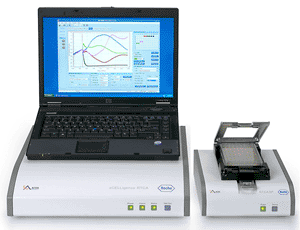Label-Free Technology Powers System for Study of Real-Time Cellular Activity
By LabMedica International staff writers
Posted on 27 Jun 2011
A new instrument based on the latest label-free technology enables drug developers and other biotech researchers to study real-time cellular events in a noninvasive and user-friendly manner.Posted on 27 Jun 2011
Users of the Roche Applied Science (Basel, Switzerland) xCELLigence system will be particularly interested in the instrument's ability to measure G protein-coupled receptor (GPCR) activation electrical impedance. GPCRs comprise a large protein family of transmembrane receptors--found only in eukaryotes--that sense molecules outside the cell and activate inside signal transduction pathways and, ultimately, cellular responses. The ligands that bind and activate these receptors include light-sensitive compounds, odors, pheromones, hormones, and neurotransmitters, and vary in size from small molecules to peptides to large proteins. G protein-coupled receptors are involved in many diseases, and are also the target of approximately 30% of all modern medicinal drugs.

Image: The xCELLigence System, designed to monitor cellular events in real time (Photo courtesy of Roche Applied Science).
The xCELLigence System monitors cellular events in real time without the incorporation of labels by measuring electrical impedance across interdigitated microelectrodes integrated on the bottom of tissue culture E-Plates. The impedance measurement provides quantitative information about the biological status of the cells, including cell number, viability, and morphology.
Compared to standard readout technologies one of the major advantages of label-free technologies is that cellular processes are measured in real-time kinetics in a noninvasive manner. The xCELLigence RTCA HT (real-time cellular analysis high-throughput) instrument is able to perform fully automated impedance screens for GPCRs and other targets in the 384-well high-throughput format. The instrument is readily integrated into automated workflows, and it delivers a highly reproducible data set.
Related Links:
Roche Applied Science













